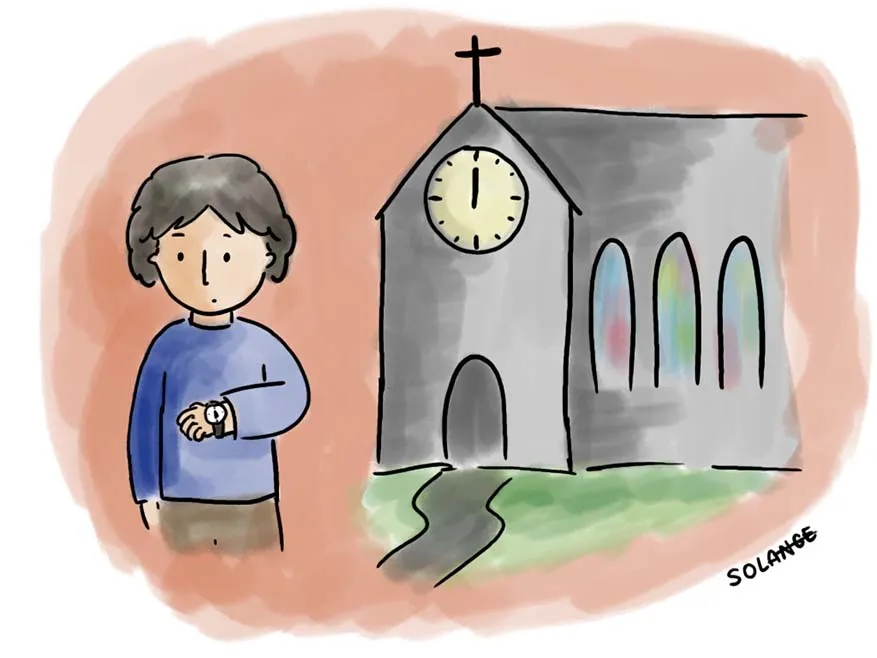My grandmother says that in times past in her city people would take a break at noon and wherever they were, whether in the fields or doing any other work, and they would begin to pray the Angelus. Her city was small and she remembers that it was something very beautiful to see how everything stopped for a few minutes to greet Our Lady. She says, “It was as if at that moment the Earth spoke with Heaven.” It must have been something very moving to see.
It took almost three centuries for the Angelus to become what we pray today. History tells that us it was Fr. Benito of Arezzo around the year 1250 who began to sing or recite, at nightfall, the antiphon: “The angel spoke to Mary ” while the bells rang. The first official document of the Angelus is found in a catechism printed in Venice in the year 1590 with an indulgence granted by Pope Paul III. Benedict XII in 1724 encouraged prayer by granting with the short ” Iniunctae nobis”, one hundred days of indulgence for each time they prayed and a plenary session a month to which they prayed it daily on their knees in the morning, at noon and in the afternoon at the ringing of the bells. Benedict XIV established on April 20, 1742, that during the Easter season the Angelus should be replaced by the antiphon: Regina Coeli . And in 1815, Pius VII added to the Angelus three glories to the Father in thanksgiving “for the gifts abundantly bestowed by the Holy Trinity to the Virgin, particularly for her glorious Assumption into heaven.”
Praying the Angelus is no longer as common as it once was, except for the traditional prayer on Sundays in St. Peter’s Square directed by the Pope himself. In the rest of the world, this prayer is carried out in a specific way within some churches and in private in communities of religious and consecrated laity.
With today’s article, we’ll do our best to rescue a beautiful Catholic custom as we teach you to pray it! 🙂
A Visual Guide To Praying The Angelus
1. Where and how do you pray The Angelus?

Traditionally, the Angelus is prayed at noon, but it used to also be prayed in the morning (6:00 am) and in the afternoon at sunset (6:00 pm). Although you are not going to pray the Angelus if you are in the middle of a conversation, the idea is to pause (it does not last more than 5 minutes) and start praying it, perhaps you can invite whoever is with you to pray it too.
2. It’s Best Prayed In A Group Setting With A Lead And Response

This beautiful prayer is the account of the Annunciation and offers a wonderful resource for everyday meditation. Two voices are prayed and after each stanza, a Hail Mary is said. It is customary to genuflect or bow when we pray the words “and dwelt among us” as a sign of gratitude to God.
V. The Angel of the Lord declared unto Mary.
R. And she conceived of the Holy Spirit.
Hail Mary, full of grace,
The Lord is with Thee;
Blessed art thou among women,
And blessed is the fruit of thy womb, Jesus.
Holy Mary, Mother of God,
Pray for us sinners,
Now and at the hour of our death. Amen
V. Behold the handmaid of the Lord.
R. Be it done unto me according to thy word.
Hail Mary, etc.
V. And the Word was made Flesh.
R. And dwelt among us.
Hail Mary, etc.
V. Pray for us, O holy Mother of God.
R. That we may be made worthy of the promises of Christ.
LET US PRAY
Pour forth, we beseech Thee, O Lord, Thy grace into our hearts, that we to whom the Incarnation of Christ Thy Son was made known by the message of an angel, may by His Passion and Cross be brought to the glory of His Resurrection. Through the same Christ Our Lord. Amen.
3. During the Easter season, it’s prayed differently

During the Easter season (including Pentecost), instead of the Angelus, the Regina Coeli is prayed , a prayer that invites us to rejoice together with Mary for the Resurrection of Our Lord Jesus.
Reigina Coeli (Queen of Heaven)
V. Queen of Heaven, rejoice, alleluia.
R. For He whom you did merit to bear, alleluia.
V. Has risen, as he said, alleluia.
R. Pray for us to God, alleluia.
V. Rejoice and be glad, O Virgin Mary, alleluia.
R. For the Lord has truly risen, alleluia.
Let us pray. O God, who gave joy to the world through the resurrection of Thy Son, our Lord Jesus Christ, grant we beseech Thee, that through the intercession of the Virgin Mary, His Mother, we may obtain the joys of everlasting life. Through the same Christ our Lord. Amen.
“What we have to say about the Angelus is meant to be only a simple but earnest exhortation to continue its traditional recitation wherever and whenever possible. The Angelus does not need to be revised, because of its simple structure, its biblical character, its historical origin which links it to the prayer for peace and safety, and its quasi-liturgical rhythm which sanctifies different moments during the day, and because it reminds us of the Paschal Mystery, in which recalling the Incarnation of the Son of God we pray that we may be led “through his passion and cross to the glory of his resurrection.”(109) These factors ensure that the Angelus despite the passing of centuries retains an unaltered value and an intact freshness. It is true that certain customs traditionally linked with the recitation of the Angelus have disappeared or can continue only with difficulty in modern life. But these are marginal elements. The value of contemplation on the mystery of the Incarnation of the Word, of the greeting to the Virgin, and of recourse to her merciful intercession remains unchanged. And despite the changed conditions of the times, for the majority of people there remain unaltered the characteristic periods of the day-morning, noon and evening-which mark the periods of their activity and constitute an invitation to pause in prayer.” – PAUL VI
Over 115 Of The Best Catholic Gifts































